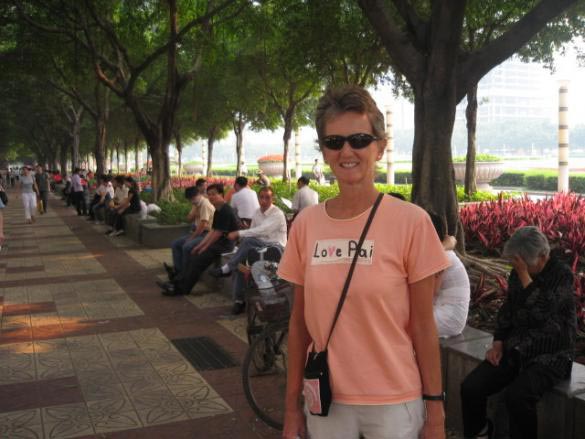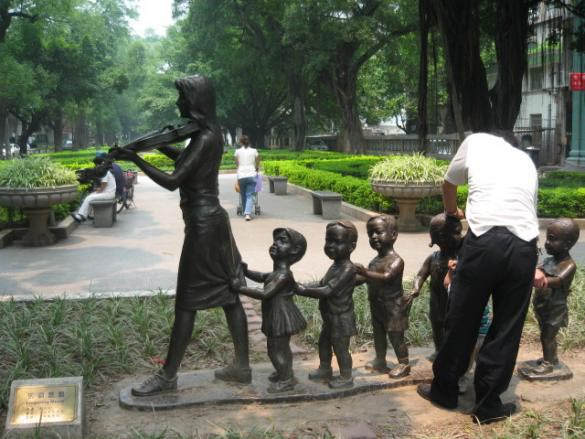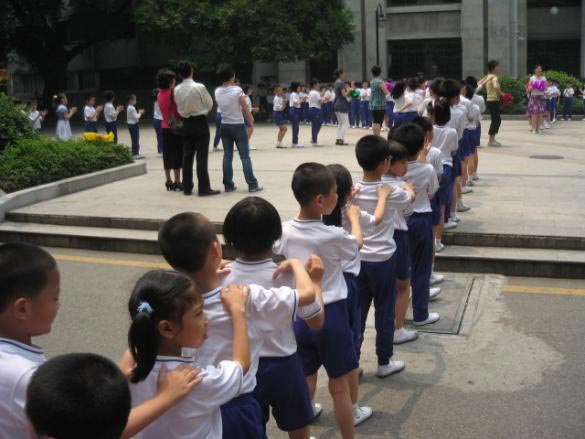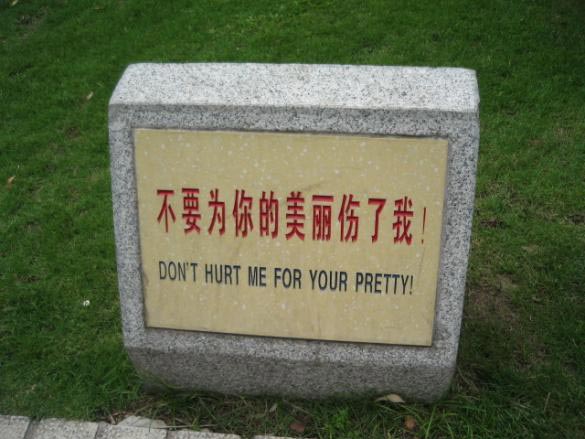
 The Yellow Sky of Guangzhou
The Yellow Sky of Guangzhou
Is it possible that the residents of Guangzhou will never again see blue sky or
that the children might grow up and never view the horizon, or expect sunsets
to be anything but the fiery orb that now burns through the layers of the smog?
As I stared out the hotel window at the soccer field across the street, the
onerous yellow haze of pollution obscured the grounds and it seemed as if a
wildfire had just swept through the area.
So far, this was the smoggiest city I’ve ever been in, with many
other people saying that Beijing
is much worse. We were grateful for the occasional cleansing rainstorm that
provided a respite of relief, and despite frequent use of eye drops, we found ourselves
constantly blinking and clearing our throat. In two months, we’ll be in Beijing just prior to the
Olympics, so it will be interesting to see if rumors of the pollution in this
metropolis hold true.

 Overnight Bus From Guilin to Guangzhou
Overnight Bus From Guilin to Guangzhou
After reluctantly leaving the fresh air of Yangshuo, we
arrived in Guangzhou
on an overnight sleeper bus, an uneventful trip that passed by quickly. Overnight
sleeper buses are my least favorite means of transportation, with complete
strangers laid end to end and stacked in two layers, with your personal space
about the size of an REI mummy sleeping bag.
Unfortunately, each sleeping bed is sized for the tallest Asian,
so if you’re longer than five feet, ten inches, your ankles will run out of
room and you’ll end up lying flat in a crouched and uncomfortable position. Something
I call horizontal fetal. The best I can expect is to doze off periodically
while humming along to my U2 collection on the ipod. Just when you finally nod
off, expect a pit stop where zombied passengers alight and absently wander
around while considering whether or not to ingest the marginal food on display.

 Author’s Wife at Guangzhou Park
Author’s Wife at Guangzhou Park
Guangzhou, formerly known as Canton, has been an
important trading port since 200 BC. Once trafficking in tea and opium, it’s now
a mega industrial and manufacturing magnet, with an escalating population
approaching 7 million. Skyscrapers are everywhere, with erector set cranes
poking into the sky like a flock of mechanical storks. Western style consumer
stores and malls are commonly found, and glassy high-rise buildings dot the
horizon, all in a headlong rush towards modernization and 21st century commerce.
We were staying at the Westin Guangzhou for three nights, where
we frugally cashed in hotel points for very luxurious accommodations. Conveniently
located a block away from a brand new subway station, the two-line metro affords
quick and easy access to the other sites in town. So what’s to do in Guangzhou?

 Entrance to Mausoleum of the Nanyue King
Entrance to Mausoleum of the Nanyue King
A worthwhile outing is a visit to the Mausoleum of the
Nanyue King, a 2000-year-old gravesite discovered in 1983 by workers who were excavating
a hillside for an apartment complex. Fortunately, this remarkable site was
undiscovered and therefore not plundered, and today appears the same as it was
when they buried the ancient king Zhao
Mo.
Nowadays, the gravesite has been made into a fascinating
museum, with artifacts from the site preserved and displayed, including the
impressive burial suit, composed of thousands of jade tiles sewn together with
silken threads. Other display cabinets feature gold jewelry, carved trinkets,
and other relics found in the tomb, all neatly presented and explained. Also shown
are the somewhat macabre bones of the unfortunate servants and virgins who were
sacrificed at the gravesite to accompany the king on his journey to the other
side. The actual burial site, with its dirt catacomb chambers locked behind thick
wooden doors and supported by giant metal hinges (parts of which are still
intact), have also been preserved, so you get an extraordinary impression of
what the archeologists discovered and how it was meticulously dug out. Well
done, and highly recommended.

 Pleasant Shamian Island
Pleasant Shamian Island
We also took the Metro down to Shamian
Island, a uniquely preserved tree-lined
historical district set along the Pearl River.
We spent the day wandering around, ducking into an occasional teashop, window
shopping, watching the locals play checkers, and appreciating the fine
historical buildings.
This peaceful oasis contains many British and French
colonial structures which were built in the 1850’s, with many converted into
upscale restaurants, hotels and shops.
It was delightful to watch the young kids on recess parade
around

 Kids At Recess on Shamian Island
Kids At Recess on Shamian Island
the square in ordered lines and circles to the accompaniment of a
blaring soundtrack from one of the school windows.
To the chorus of the boom
box, the kids all shouted in unison and hopped around the yard, energetic and
fresh, perhaps practicing their alphabet, or counting to ten?
Waterfront cafes
and outdoor beer gardens completed the scene, while on the paths that fronted
the Pearl River, singers sang out their songs
and locals practiced their dance moves to the accompaniment of impromptu amateur
bands.

 Pedestrian Mall of Guangzhou
Pedestrian Mall of Guangzhou
Just a few blocks inland from Shamian Island,
the colorful shopping street of Xia Jiulu offers hours of entertainment as we
wandered the pedestrian street and poked our heads into the stores offering
discounted clothing. Nearby Haizhu
Square also offers discounted merchandise, while
close by, the densely packed Beijing Lu is crammed full with local merchants
and shoppers eager to barter. Cheap, authentic food is available everywhere.
We spent another day at Yuexiu
Park, a sizeable stretch of urban
greenery in the center of Guangzhou,
with wonderful gardens, shaded paths, lakes with boat rentals, and families out
having fun. Within its grounds, you’ll find the popular “Five Rams Statue,” a
tribute to the eternal founders of the city, as well as the Guangzhou City
Museum and the Guangzhou Art
Gallery.

 I Think This Means Stay Off The Grass
I Think This Means Stay Off The Grass
My wife is able to communicate with the locals despite her
limited vocabulary, although she still hasn’t been able to acquire a pill
splitter from a pharmacy despite heroic efforts.
I thought that displaying a
pill, then indicating a chopping motion with your hand, would be sufficient, but
it isn’t.
We haven’t had any problems getting around, although it helps that
we’re not on any strict timetable, which allows time to figure out connections
to our next destination.

 This One I Understand
This One I Understand
The Chinese are an impatient lot and you need to be wary of
their annoying habit of cutting into queues instead of waiting their turn in
line. This can occur at a busy ticket counter, at the railway station, or at a
taxi line. When you get off the train in a busy metro area, people hurry from
the platform to stand in line for a taxi. Generally, the line is well behaved,
with taxis arriving at the front of the line and picking up the next available
group. However, inevitably, people cut in at the front of the line, rather than
walking to the end. In America,
this would cause pushing and shoving and a probable fight, but here, people
shrug and accept it.
While you’re trying to purchase your ticket at the train
station, don’t be surprised when people cut in, pushing money at the agent
while demanding a ticket. I try to form a ring of protection around my wife
when she’s standing at a counter, to out flank and block out anyone thinking of
cutting in. Still, in China
it’s acceptable behavior, so don’t get too upset, just smile and invoke the
universal words of “sorry” or “excuse me.”

 Slit Pants on Baby
Slit Pants on Baby
Another thing we found curious are babies that don’t wear
diapers. Instead, the baby pants are slit around the crotch from the front to
the back, so that when they do have to go to the bathroom, mom, or dad just
sets them down, spreads their legs, and lets them go. We suppose it’s better
for the baby in that there’s less diaper rash, but the first time you see it,
you have to wonder.
Overall, China is interesting, and people are very friendly, although English is not widely
spoken or perhaps the Chinese are too shy to speak it. Fortunately, we had seven
months of Asian travel under our belts before arriving here; otherwise, I think
our frustration level would be high. China is the land of big cities and
billions of people, but the transportation systems are wide spread,
inexpensive, modern, and very easy to figure out, although it helps to have
your destination written out in Chinese characters.
After our stay here in Guangzhou,
it’s a two-hour express train to Hong Kong
where we’ll spend a week. No, I would not add this city to our must see list of
places, but if you have a decent place to stay at an affordable price, then
certainly plan on a few days before continuing east to Hong Kong.

 The Author in Downtown Guangzhou
The Author in Downtown Guangzhou
Visit the king’s mausoleum, wander around Shamian Island,
poke around the busy shopping streets, and indulge in the many food offerings.
Lonely Planet notes that Guangzhou is “quite
special among China’s
major urban centers” and that it takes “some time to grow on you.” Perhaps this
sprawling metropolis will grow on you too. Now, if they could just do something
about that yellow sky.